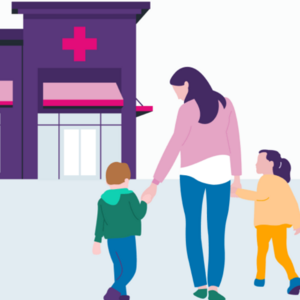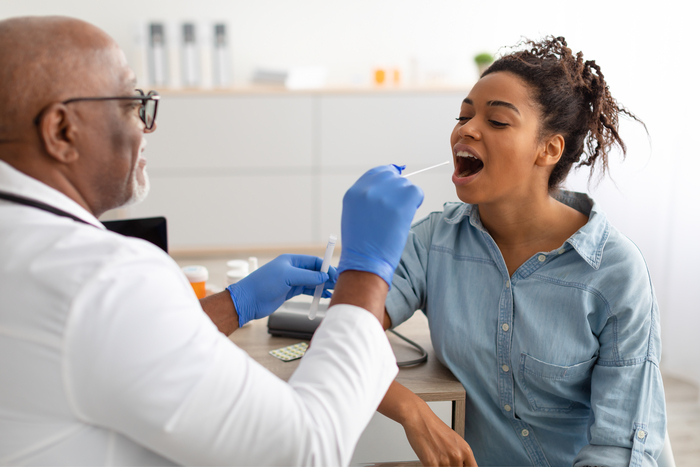
Feel better faster. Get care today.
From the clinic or your couch. Find high quality, same-day urgent care for you and your kids. Book an urgent care visit today.

Strep throat is a frequent bacterial infection which primarily affects the throat and tonsils, causing severe discomfort and pain. It is also a highly contagious type of bacterial infection that results in the development of sore throat and often fever, as well as inflamed lymph nodes (glands) — it affects all ages but is more common amongst children according to the American Academy of Pediatrics (AAP). Read on to get a better understanding of strep throat symptoms, causes and treatment options to manage this common illness effectively.
Strep throat is an infectious disease caused by the Group A Streptococcus bacteria, according to the American Academy of Family Physicians (AAFP) — which primarily targets the throat and tonsils. This condition is known for its sudden onset and can lead to severe throat pain, making swallowing difficult — and although strep throat is particularly common in children it can affect individuals of any age.
The AAFP explains that strep throat is contagious and can easily spread from person to person. The bacteria are typically transmitted through respiratory droplets when an infected person coughs or sneezes. Additionally, sharing food, drinks, or utensils with someone who has strep throat can also facilitate the spread of the infection. Practicing good hygiene, such as frequent handwashing and avoiding close contact with sick people can help minimize the risk of transmission.

From the clinic or your couch. Find high quality, same-day urgent care for you and your kids. Book an urgent care visit today.
Strep throat is not only a painful condition but also a highly contagious one as well. It is primarily caused by the Group A Streptococcus bacteria, which can be easily transmitted from an infected person to others, according to the CDC. They explain that the bacteria spread through respiratory droplets released when an infected individual coughs, sneezes, or talks.
Close contact with someone who has strep throat, such as hugging or sharing personal items like utensils or drinks, can also facilitate the transmission. Additionally, the bacteria can survive on surfaces for a short period, allowing for indirect transmission if someone touches a contaminated surface and then their mouth or nose. This ease of spread underscores the importance of maintaining good hygiene practices to prevent infection, especially in communal environments.
Recognizing the symptoms of strep throat is important because it can help you or your child get timely diagnosis and treatment.
Common Symptoms of Strep Throat, according to the CDC, include:
Throat pain that can be severe
Painful swallowing
Red and swollen tonsils, sometimes with white patches or streaks of pus
Fever, often above 101°F (38.3°C)
Headache
Body aches or general discomfort
Rash, which may appear in some cases
Nausea or vomiting, particularly in younger children
Swollen lymph nodes in the neck
Loss of appetite
Preventing strep throat is the most effective way to reduce the risk of infection, especially in environments where the bacteria can easily spread such as schools, daycares, nursing homes, or hospitals. Some practical tips from the CDC to help minimize their chances of contracting strep throat include:
Wash your hands frequently with soap and water, especially after coughing, sneezing, or being in public places.
Use an alcohol-based hand sanitizer when soap and water are not available.
Cough and sneeze into a tissue or your elbow to prevent the spread of respiratory droplets.
Avoid sharing cups, utensils, or personal items with others to reduce the risk of transmission.
Stay away from individuals who are exhibiting symptoms of strep throat to minimize exposure.
Doctors typically begin the treatment process by conducting a thorough examination and may perform a rapid strep test or throat culture to confirm the presence of Group A Streptococcus bacteria, according to the CDC. If the test is positive, they will often prescribe antibiotics — which are effective in eliminating the bacteria and reducing the duration of symptoms. Common antibiotics for strep throat include penicillin and amoxicillin, which not only help to clear the infection but also lower the risk of complications, such as rheumatic fever or kidney inflammation according to the CDC.
In addition to antibiotics, the CDC notes that doctors may recommend supportive care to relieve symptoms. This can include over-the-counter pain relievers, such as ibuprofen or acetaminophen, to help reduce fever and throat pain. Staying hydrated and resting are also crucial components of recovery. The CDC stresses that following the prescribed treatment plan and completing the full course of antibiotics, even if symptoms improve, is extremely important to ensure the infection is fully eradicated and to prevent recurrence.
While some symptoms may be manageable at home, certain signs indicate the need for professional evaluation and care, according to the AAFP.
Swollen lymph glands in the neck that are painful or tender
A sore throat that lasts longer than 48 hours without improvement
A persistent fever, especially if it exceeds 101°F (38.3°C)
A sore throat accompanied by a rash, which may indicate a more serious condition
Difficulty breathing or swallowing, which could signal complications
Severe headache or stomach pain that accompanies throat symptoms
Find and book same-day appointments for top-rated urgent cares, lab tests and telemed. Download the Solv app today! Convenient care, simplified with Solv.
Strep throat is a bacterial infection primarily affecting the throat and tonsils, causing severe discomfort and pain. It is caused by the Group A Streptococcus bacteria and is known for its sudden onset. While it is more common in children, it can affect individuals of any age.
Strep throat is highly contagious and can easily spread from person to person. The bacteria are typically transmitted through respiratory droplets when an infected person coughs or sneezes. Sharing food, drinks, or utensils with someone who has strep throat can also facilitate the spread of the infection.
Symptoms of strep throat include severe throat pain, painful swallowing, red and swollen tonsils, fever often above 101°F (38.3°C), headache, body aches, rash, nausea or vomiting, swollen lymph nodes in the neck, and loss of appetite.
Preventive measures include frequent handwashing, especially after coughing or sneezing, using an alcohol-based hand sanitizer when soap and water are not available, avoiding sharing cups, utensils, or personal items with others, and staying away from individuals who are exhibiting symptoms of strep throat.
Doctors typically perform a rapid strep test or throat culture to confirm the presence of Group A Streptococcus bacteria. If the test is positive, they will prescribe antibiotics, which are effective in eliminating the bacteria and reducing the duration of symptoms. Over-the-counter pain relievers may also be recommended to help reduce fever and throat pain. It's crucial to complete the full course of antibiotics, even if symptoms improve, to ensure the infection is fully eradicated and to prevent recurrence.